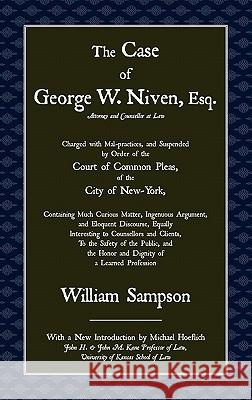The Case of Geoge W. Niven, Esq. » książka
The Case of Geoge W. Niven, Esq.
ISBN-13: 9781616190255 / Angielski / Twarda / 2011 / 104 str.
The Case of Geoge W. Niven, Esq.
ISBN-13: 9781616190255 / Angielski / Twarda / 2011 / 104 str.
(netto: 215,20 VAT: 5%)
Najniższa cena z 30 dni: 217,02 zł
ok. 30 dni roboczych.
Darmowa dostawa!
George W. Niven was a lawyer and con-man who cheated his victims, all incarcerated prostitutes, pickpockets and other petty criminals, by promising legal help and taking their meager property in exchange. Since it involved a corrupt lawyer, criminals and venal jailors, his trial was a perfect subject for a trial report, one of the most popular genres of antebellum literature. This trial, frequently cited in later histories of American law, is equally important as an early source for the history of legal malpractice litigation in the U.S. and its description of the practice of a lawyer at the margins of the profession. The affidavits of Niven's victims also provides a great deal of vital information about the daily lives of prisoners in the early decades of the Republic. William Sampson 1764-1836] was an Irish rights activist whose part in the Uprising of 1798 led to his relocation to New York, where he engaged in a successful law career.
George W. Niven was a lawyer and con-man who cheated his victims, all incarcerated prostitutes, pickpockets and other petty criminals, by promising legal help and taking their meager property in exchange. Since it involved a corrupt lawyer, criminals and venal jailors, his trial was a perfect subject for a trial report, one of the most popular genres of antebellum literature. This trial, frequently cited in later histories of American law, is equally important as an early source for the history of legal malpractice litigation in the U.S. and its description of the practice of a lawyer at the margins of the profession. The affidavits of Nivens victims also provides a great deal of vital information about the daily lives of prisoners in the early decades of the Republic.William Sampson [1764-1836] was an Irish rights activist whose part in the Uprising of 1798 led to his relocation to New York, where he engaged in a successful law career.











